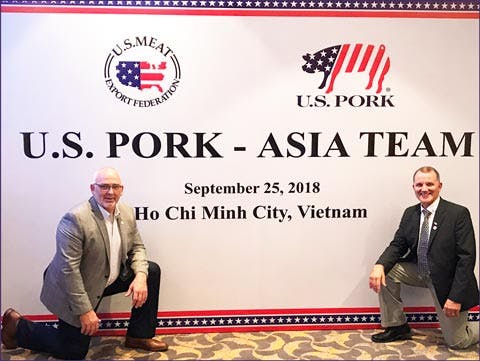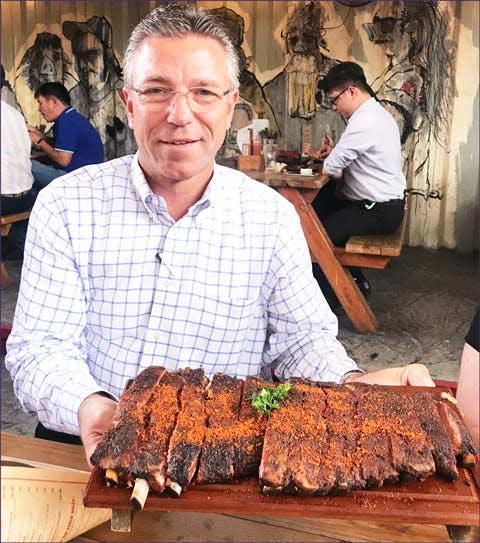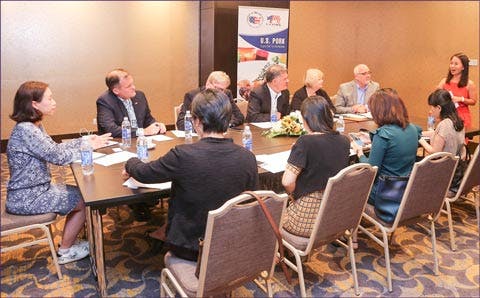U.S. Pork Asia Team Takes Deep Dive into Growing Vietnamese Market
Vietnam’s cities and its overall economy are experiencing rapid growth, with consumers having more money to spend and more options on how to spend it.

Randy Spronk (left) of Minnesota and Bill Luckey of Nebraska, both members of the National Pork Board’s International Marketing Committee, stop for a photo on a USMEF-organized exploratory mission to Singapore and Vietnam
This growth – and the potential for even more – was on the minds of U.S. pork industry leaders on a recent exploratory trip to Southeast Asia organized by USMEF. The U.S. Pork Asia Team, which included members of the National Pork Board’s (NPB) International Marketing Committee and other U.S. pork industry leaders, was given an up-close look at USMEF’s work to increase demand for U.S. pork in Singapore and Vietnam.

Glenn Stolt, CEO of Christensen Farms, a producer and processor of pork in Minnesota, displays U.S. pork ribs served in a Ho Chi Minh City restaurant
Led by USMEF Senior Vice President for the Asia-Pacific Joel Haggard and Sabrina Yin, USMEF director in the ASEAN, the team visited processing plants and supermarkets and met face-to-face with key importers and traders to build relationships in the region. There was also an emphasis on learning about lifestyle trends and getting a better understanding of consumers’ culinary preferences.
The mission’s overall goal was simple: learn the intricacies of these markets and identify ways to export more pork into them.
“The U.S. pork industry has a lot of supply, so we were investigating which international markets we need to target – where we should be putting more resources and funding to grow U.S. pork exports and move more product,” said Randy Spronk, a hog producer from Minnesota who is a member of NPB’s International Marketing Committee and chairs the USMEF Pork and Allied Industries Committee. “This trip with USMEF was a great opportunity to look at existing and emerging markets. We talked about the attributes of U.S. pork that are valuable in what has become a high-end market like Singapore, and we sought to find out what cuts they were looking for and how we can advance and increase sales in that market. We then transitioned into Vietnam, which is emerging and has a lot of potential as a growth market.”

Vietnamese students stop at a U.S. pork retail promotion in Ho Chi Minh City
John Hinners, USMEF vice president for industry relations, said a majority of the U.S. pork producers on the trip had never seen the Southeast Asian markets in person.
“That firsthand knowledge of a market is very important for industry leaders when they come back home and make decisions about funding programs and projects like those we have going on in Southeast Asia,” said Hinners. “Along with showing them the markets, we also showcased how USMEF is leveraging U.S. dollars – from the pork industry and from the grain industry – to create and grow demand for U.S. pork.”

The U.S. pork team took part in a press conference arranged by the National Pork Board
A U.S. pork trade seminar allowed the team to meet with Vietnamese importers and exchange information about Vietnam’s wants and needs. More than 40 pork buyers from the region attended a briefing lunch during which USMEF Trade Analyst Jessica Spreitzer gave attendees an update on U.S. pork supply and current trends in the international marketplace. Meetings with government and industry association officials were also arranged by USMEF, allowing the U.S. pork team to learn about trade policy and market access issues in Vietnam.
USMEF retail promotions in Ho Chi Minh City were important segments of the visit, noted Haggard, who explained that Vietnam’s domestic pork prices are very high and that imports from Poland, which had been the country’s largest pork supplier, are restricted due to African swine fever concerns.
“Vietnam’s pork self-sufficiency remains high, but with prices increasing for domestic pork and bigger cities now having infrastructure in place to handle more imports, there is potential,” said Haggard. “During this mission, we fielded several questions about pricing for U.S. pork muscle cuts.”
Value-wise, the U.S. exported more than $12 million of pork and pork variety meat to Vietnam in 2017, second only to the Philippines in Southeast Asia. So far in 2018, U.S. pork exports have been brisk. Haggard said shipments of U.S. pork have tripled since July, as Vietnamese importers and distributors prepare for the typically pork consumption-heavy autumn season.
“We were very happy to give the pork leaders insight into the market, because Vietnam is an emerging powerhouse,” said Haggard. “The population is about 90 million and the country has an educated and skilled workforce. Vietnam is also expanding its manufacturing sector, so there’s a lot of promise, economically speaking.”
Along with Singapore and Vietnam, the U.S. Pork Asia Team tour included stops in Hong Kong and Macau.
